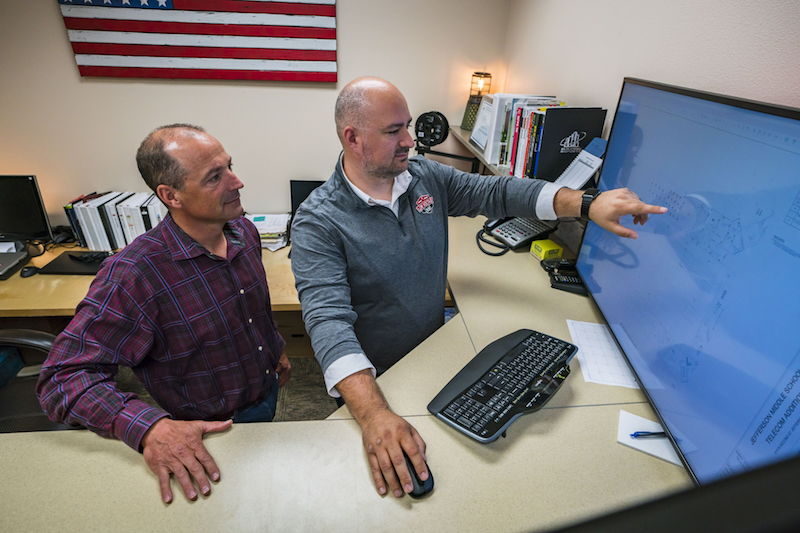At Low Voltage NW, we understand that fire safety inspections can feel daunting for property managers and business owners. These inspections aren’t just a formality — they’re critical to ensuring the safety of your staff, tenants, and customers. But preparation doesn’t have to be overwhelming. With the right planning and reliable systems in place, you can face your next fire safety inspection with confidence.
Here’s a comprehensive guide to help your commercial property prepare for fire safety inspections and avoid common pitfalls.
1. Understand local fire codes
Fire codes can vary depending on your city, county, or state. These regulations determine the standards your property must meet, covering areas such as fire alarms, sprinkler systems, emergency lighting, and fire extinguishers. Familiarize yourself with these codes or consult with a local expert.
At Low Voltage NW, we’re well-versed in local fire safety requirements and can ensure your systems are compliant, saving you from last-minute surprises.
2. Conduct routine maintenance
Proactive maintenance is your best defense against fire safety issues. Schedule regular inspections of all fire safety equipment, including:
- Fire Alarms: Ensure they’re fully operational, tested regularly, and have batteries replaced as needed.
- Sprinkler Systems: Check for leaks, corrosion, or blockages.
- Emergency Lights and Exit Signs: Verify they’re functional and visible.
- Fire Extinguishers: Confirm they’re easily accessible, properly charged, and not expired.
A comprehensive maintenance schedule ensures that all systems are in peak condition and ready for inspection.
3. Test your fire alarm and detection systems
Your fire alarm system is at the heart of your fire safety strategy. Schedule periodic testing to confirm that:
- Smoke and heat detectors respond appropriately.
- Notification systems, including horns, strobes, and voice evacuation messages, are working correctly.
- The fire panel is functioning and provides accurate status updates.
Low Voltage NW can assist with advanced testing procedures and ensure your fire alarm systems are integrated with other safety solutions, such as monitoring services.
4. Train your staff
Even the most sophisticated fire safety systems are only as effective as the people using them. Conduct fire safety training sessions to:
- Familiarize staff with evacuation routes and procedures.
- Teach proper use of fire extinguishers.
- Review roles and responsibilities during an emergency.
Training creates a culture of safety and helps everyone respond effectively during inspections or emergencies.
5. Review emergency and evacuation plans
Every commercial property should have a clear, updated emergency plan. Key elements include:
- Evacuation Routes: Clearly marked and easily accessible.
- Assembly Points: Designated safe areas for gathering after evacuation.
- Communication Plan: How to notify employees, tenants, and emergency services.
Regularly review and update these plans to address changes in building layout, occupancy, or regulations.
6. Partner with a trusted low voltage provider
Managing fire safety in commercial properties involves a complex web of systems, from alarms and monitoring to access control and communication. Partnering with a trusted low voltage contractor ensures these systems work seamlessly together.
At Low Voltage NW, we specialize in designing, installing, and maintaining low voltage solutions tailored to your property’s needs. Our expertise in low-voltage systems helps businesses stay prepared for inspections and emergencies alike.
7. Schedule a pre-inspection audit
A pre-inspection audit can highlight potential issues before the official inspection. During this audit, a professional evaluates your property to:
- Identify non-compliance issues.
- Test all fire safety systems.
- Recommend immediate fixes or upgrades.
Low Voltage NW offers pre-inspection audits to ensure your property is inspection-ready and compliant with all regulations.
8. Keep documentation organized
Inspectors often require records to verify compliance. Keep the following documents readily available:
- Fire alarm system test reports.
- Maintenance logs for fire safety equipment.
- Evacuation and emergency plans.
- Records of staff training sessions.
Having these documents organized and accessible shows inspectors that your property prioritizes safety.
9. Stay proactive, not reactive
Fire safety isn’t a one-time effort. Consistent maintenance, ongoing training, and regular audits prevent issues from escalating. By staying proactive, you can identify potential risks early, resolve small problems before they grow, and ensure that all systems are always in top condition. Regular internal reviews and professional consultations help keep your property safe and inspection-ready at all times.
A proactive approach not only ensures compliance but also protects lives, minimizes property damage, and demonstrates your commitment to safety.
10. Choose Low Voltage NW for your fire safety needs

Fire safety inspections don’t have to be stressful. By partnering with Low Voltage NW, you gain a dedicated team committed to your property’s safety and compliance. We provide:
- Comprehensive fire alarm system installation and maintenance.
- Customized low voltage solutions for commercial properties.
- Expert guidance on meeting local fire codes.
When you’re ready to prepare for your next fire safety inspection, give us a call. Together, we’ll make sure your property is not only compliant but also equipped to handle any emergency with confidence.
Contact Low Voltage NW today to schedule a consultation and ensure your property’s fire safety systems are ready for inspection.






